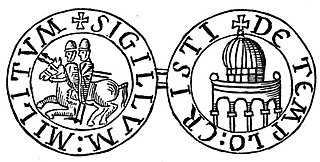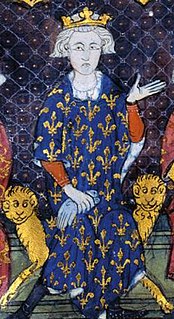
The Poor Fellow-Soldiers of Christ and of the Temple of Solomon, also known as the Order of Solomon's Temple, the Knights Templar or simply the Templars, was a Catholic military order founded in 1118, headquartered on the Temple Mount in Jerusalem through 1128 when they went to meet with Pope Honorius II. They were recognized in 1139 by the papal bull Omne datum optimum of Pope Innocent II. The order was active until 1312 when it was perpetually suppressed by Pope Clement V by the bull Vox in excelso.

Pope Clement V, born Raymond Bertrand de Got, was head of the Catholic Church and ruler of the Papal States from 5 June 1305 to his death in April 1314. He is remembered for suppressing the order of the Knights Templar and allowing the execution of many of its members. Pope Clement V was the pope who moved the Papacy from Rome to Avignon, ushering in the period known as the Avignon Papacy.

The Avignon Papacy, also known as the Babylonian Captivity, was the period from 1309 to 1376 during which seven successive popes resided in Avignon rather than in Rome. The situation arose from the conflict between the papacy and the French crown, culminating in the death of Pope Boniface VIII after his arrest and maltreatment by Philip IV of France. Following the further death of Pope Benedict XI, Philip forced a deadlocked conclave to elect the French Clement V as pope in 1305. Clement refused to move to Rome, and in 1309 he moved his court to the papal enclave at Avignon, where it remained for the next 67 years. This absence from Rome is sometimes referred to as the "Babylonian captivity of the Papacy".

Philip IV, called Philip the Fair, was King of France from 1285 to 1314. By virtue of his marriage with Joan I of Navarre, he was also King of Navarre as Philip I from 1284 to 1305, as well as Count of Champagne. Although Philip was known to be handsome, hence the epithet le Bel, his rigid, autocratic, imposing and inflexible personality gained him other nicknames, such as the Iron King. His fierce opponent Bernard Saisset, bishop of Pamiers, said of him: "he is neither man nor beast. He is a statue."

Jacques de Molay, also spelled "Molai", was the 23rd and last grand master of the Knights Templar, leading the order from 20 April 1292 until it was dissolved by order of Pope Clement V in 1312. Though little is known of his actual life and deeds except for his last years as Grand Master, he is one of the best known Templars.

The Council of Vienne was the fifteenth ecumenical council of the Catholic Church that met between 1311 and 1312 in Vienne, France. Doctrinally, it defined the human soul as being essentially and by itself the form of the human body - in line with Aristotelian metaphysics, which had risen to prominence in 13th century Catholic Europe with the commentaries of Dominican friars such as Albertus Magnus and Thomas Aquinas. One of its other principal acts was to withdraw papal support for the Knights Templar on the instigation of Philip IV of France, after the French monarch attacked Rome and killed Pope Boniface VIII.

Geoffroi de Charney, also known as Guy d'Auvergne, was preceptor of Normandy for the Knights Templar. De Charney was accepted into the Order of Knights Templar at a young age by Amaury de la Roche, Preceptor of France. Present at the ceremony was brother Jean le Franceys, preceptor of Pédenac. In 1307 de Charny was arrested, along with the entire Order of Knights Templar in France, and in 1314 was burned at the stake.

The Military Order of Christ, before 1910 Royal Military Order of Our Lord Jesus Christ, previously the Order of the Knights of Our Lord Jesus Christ, is the former Knights Templar order as it was reconstituted in Portugal after the Templars were abolished on 22 March 1312 by the papal bull, Vox in excelso, issued by Pope Clement V. The Order of Christ was founded in 1319, with the protection of the Portuguese king, Denis, who refused to pursue and persecute the former knights as had occurred in most of the other sovereign states under the political influence of the Catholic Church.

Rothley Temple, or more correctly Rothley Preceptory, was a preceptory in the village of Rothley, Leicestershire, England, associated with both the Knights Templar and the Knights Hospitaller.
The Chinon Parchment is a historical document discovered in September 2001 by Barbara Frale, an Italian paleographer at the Vatican Secret Archives. On the basis of this document she has claimed that, in 1308, Pope Clement V absolved the last Grand Master, Jacques de Molay, and the rest of the leadership of the Knights Templar from charges brought against them by the Medieval Inquisition.
Vox in excelso is the name of a bull issued by Pope Clement V in 1312. The directives given within the bull were to formally dissolve the Order of the Knights Templar, effectively removing papal support for them and revoking the mandates given to them by previous popes in the 12th and 13th centuries.
In view of the suspicion, infamy, loud insinuations and other things which have been brought against the order ... and also the secret and clandestine reception of the brother of this Order; in view, moreover, of the serious scandal which has arisen from these things, which it did not seem could be stopped while the Order remained in being, and the danger to faith and souls, and the many horrible things which have been done by the very many of the brothers of this Order, who have lapsed into the sin of wicked apostasy, the crime of detestable idolatry, and the execrable outrage of the Sodomites ... it is not without bitterness and sadness of heart that we abolish the aforesaid Order of the Temple, and its constitution, habit and name, by an irrevocable and perpetually valid decree; and we subject it to perpetual prohibition with the approval of the Holy Council, strictly forbidding anyone to presume to enter the said Order in the future, or to receive or wear its habit, or to act as a Templar.

Ad providam was the name of a Papal Bull issued by Pope Clement V in 1312. It built on a previous bull, Vox in excelso, which had disbanded the order of the Knights Templar. Ad providam essentially handed over all Templar assets to the Hospitallers, with the exception of some resources which were left to provide pensions to some Templars who had escaped execution and converted to a monastic life.
Events from the 1300s in England.
The original historic Knights Templar were a Christian military order, the Order of the Poor Fellow Soldiers of Christ and of the Temple of Solomon, that existed from the 12th to 14th centuries to provide warriors in the Crusades. These men were famous in the high and late Middle Ages, but the Order was disbanded very suddenly by King Philip IV of France, who took action against the Templars in order to avoid repaying his own financial debts. He accused them of heresy, ordered the arrest of all Templars within his realm, put the Order under trial and many of them burned at the stake. The dramatic and rapid end of the Order led to many stories and legends developing about them over the following centuries. The Order and its members increasingly appear in modern fiction, though most of these references portray the medieval organization inaccurately.

The Knights Templar trace their beginnings to the Latin Kingdom of Jerusalem in c. 1120 when nine Christian knights, under the auspices of King Baldwin II and the Patriarch Warmund, were given the task of protecting pilgrims on the roads to Jerusalem, which they did for nine years until elevated to a military order at the Council of Troyes in 1129. They became an elite fighting force in the Crusades known for their propensity not to retreat or surrender.
Faciens misericordiam was a papal bull issued by Pope Clement V on August 12, 1308, as part of the trial against the Knights Templar. It called for a new Ecumenical council to be held in 1310, and set out some structure for the collection of depositions from the arrested Templars.
Keele Preceptory was a preceptory, in Keele, Staffordshire, England. Owned by the Knights Templar until their suppression in the early 14th century, it then passed through a number of owners before falling into the hands of the Knights Hospitaller.
The history of the Knights Templar in England began when the French nobleman Hughes de Payens, the founder and Grand Master of the order of the Knights Templar, visited the country in 1128 to raise men and money for the Crusades.
Guillaume Bonnet was the archdeacon of Passais in the fourteenth century.











